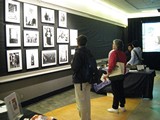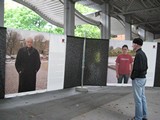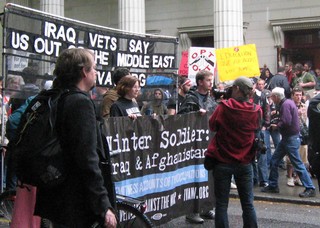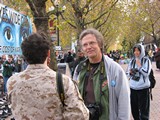So, I made it up to the Benham Gallery’s The Power of One photography exhibit our local Amnesty International group is involved with in the Northwest Rooms of Seattle Center on Friday night, for an early look before it’s run as part of Bumpershoot. It was an inspiring, and at times heart wrenching, display.

Included were photos from Phil Borges latest book, Women Empowered: Inspiring Change in the Emerging World. Borges partnered with CARE “to bring attention to the necessity of empowering women in the global campaign to alleviate poverty.” He profiled courageous women, including a teacher who continued teaching girls in secret in Afghanistan during the Taliban rule; a young woman from Ethiopia who not only refused female circumcision herself, but ended it in her community by video taping a circumcision and showing it to the male leaders who had never actually seen the procedure at the time and were horrified, voting 15 to 2 a couple weeks later to end female circumcision in their village; and a woman from Bangladesh sold into a brothel by her aunt at age 13, fighting for the rights of her fellow sex workers.

Jackie Renn’s exhibit, Portraits of Conscience: Celebrating the First Amendment During a Time of War 2002–2007 included both photos of Seattle’s protests of our current war and video interviews of conscientious objectors from WW II to the Iraq War.

Nina Berman’s photos, Purple Hearts: Back from Iraq & Marine’s Wedding were very compelling and disturbing. All photos of young men (and at least one woman) who served in our military and came back from the Iraq severely injured, some with faces disfigured, others missing limbs. We hear all about the “surge” and how the war in Iraq is all right again now from the Republicans, but at what cost, even to our own soldiers?
The photos of the Marine’s wedding, in a separate alcove (with a video of soldiers/veterans talking about the war) were especially haunting, with a wedding photo of the disfigured groom and his scared bride. I picked up a flyer that told how former Marine Sgt. Ty Ziegel had been seriously injured in by a suicide car bomber in 2004 in Iraq and how his family and his fiancee Renee Kline supported him during his recovery. They asked anyone who wants to help to send donations to Fisher House, an organization which aids military families including Ty’s.

I saw a couple of Katharina Mouratidi’s photos, The Other Globalisation inside at the entrance to the main exhibit in the Olympic room. When I left (or thought I had left) the Power of One exhibit, I discovered there were a lot more of the globalization photos outside, at the other end of the Northwest Rooms (and that people are likely to be seeing a lot just roaming around Bumpershoot between music). Mouratidi has photographed those fighting for the rights of people and the planet against the corporate dominated, “race to the bottom” globalization, including photos of people like Rigoberta Menchú , José Bové and others not so famous.
An amazing exhibit. As the card at the entrance noted: “Power of One was created to inspire and empower our inner-hero” (emphasis from original).
Here locally in Seattle, our next Amnesty International meeting is coming up Tuesday, September 2 (6:30pm at the Mosaic Coffee House). Our featured speaker will be Kathleen Morris of the Washington Anti-Trafficking Response Network and the Anti-Trafficking Program Manager at the International Rescue Committee.
More information on our meeting, including directions to the Mosaic at:
http://www.scn.org/amnesty/current.html
If you don’t live in Seattle, consider finding a local or student group near you or taking action online at either Amnesty International or Amnesty International USA (or your country’s section). I’ve also included an rss feed of AI’s most recent Urgent Actions right beneath the calendar on the left of this blog, as well as a feed for the most recent AI press releases.
Or consider one of the multitude of other activist or humanitarian groups, even if all you have time or money to do is write a suggested letter or e-mail action online every now and then or donate a few dollars. It all adds up. You do have the power.

